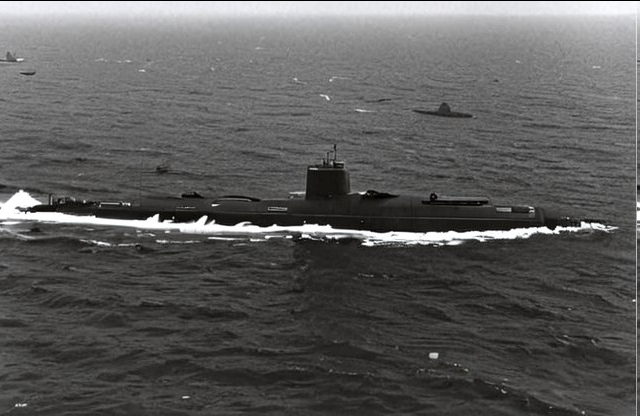Dilandu
I'm dissatisfied, which means, I exist.
In early 1950s, the USN became concerned about the potential problem with nuclear delivery systems. The only available on hands was AJ Savage bomber, which could only be launched from the large carriers. The submarine-launched Regulus cruise missile was still in development, and it wasn't really suitable for all potential warfare situations, having surface launch and complicated radio guidance system. A shorter range weapon, more suitable for tactical use, was required; but available rockets and missiles weren't exactly reliable or capable enough.
So with a sucsessfull development of M65 atomic cannon by Army, the idea was born: to revive the old concept of "big gun submarine" (or "underwater monitor") in atomic age, to fire nuclear shells against the coastal targets.

The SS-435 USS "Unicorn", an incomplete Tench-class submarine, was chosen for the experiment. The hull of boat was lenghtened by installation of additional section just in front of the sail, and a 12-inch/50 Mark-8 cannon (the same as on Alaska-class cruisers) was installed on specially-designed carriage under the hydrodynamic blister. The gun was fixed in train, but could elevate up to 45 degrees, for which purpose the trunnions were moved backward and a special recesse made in newly-added section. The cannon muzzle was equipped with protection flap to prevent water from entering, and a high-pressure pneumatic system was installed to eject water from barrel after shot.
Normally, the gun could be reloaded only on surface. But since nuclear shells were costly, and a ranging shot was required to make sure the gun is aimed correctly, a single-reload pressurized magazine (with automatic rammer) was attached directly to the gun breech section, elevating and depressing with it. Normally, the gun was loaded with ranging shell (specially filled to provide a bright flash and a cloud of highly reflective dipoles on radar), while the atomic shell and powder charge was waiting in magazine. The ranging shot was fired first, then gun adjusted accordingly, and a nuclear shell was automatically loaded.
The cannon was supposed to fire a 15-kt nuclear shell - basically a W19 gun-type nuclear shell in slightly larger casting - up to 35 km. For the purposes of aiming, a special persicope with ranging radar was installed. The idea was, that the "atomic cannon submarine" could sneak close to enemy coastline at night, raise the barrel out of water, and quickly fire first ranging, then nuclear shells. It could also be used to provide high precision nuclear strikes in support of amphibious landing or commando raids. It was also hoped, that in future a long-range sub-caliber nuclear shells (based on W33 8-inch Army shell) could be developed to allow strikes up to 55 km range, and eventually the rocket-augmented shells with the 100 km range would became available.
The XS-435 USS "Unicorn" was commissioned in 1956, as an experimental weapon-testing submarine. While the concept of "underwater atomic cannon" was proven to be workable, the complexity and disadvantages of the system became rather obvious. No 12-inch nuclear shells were actually produced, and after a series of trials the program was eventually cancelled. The USS "Unicorn" was mothballed in 1959, and sold for scrap in 1964.
So with a sucsessfull development of M65 atomic cannon by Army, the idea was born: to revive the old concept of "big gun submarine" (or "underwater monitor") in atomic age, to fire nuclear shells against the coastal targets.

The SS-435 USS "Unicorn", an incomplete Tench-class submarine, was chosen for the experiment. The hull of boat was lenghtened by installation of additional section just in front of the sail, and a 12-inch/50 Mark-8 cannon (the same as on Alaska-class cruisers) was installed on specially-designed carriage under the hydrodynamic blister. The gun was fixed in train, but could elevate up to 45 degrees, for which purpose the trunnions were moved backward and a special recesse made in newly-added section. The cannon muzzle was equipped with protection flap to prevent water from entering, and a high-pressure pneumatic system was installed to eject water from barrel after shot.
Normally, the gun could be reloaded only on surface. But since nuclear shells were costly, and a ranging shot was required to make sure the gun is aimed correctly, a single-reload pressurized magazine (with automatic rammer) was attached directly to the gun breech section, elevating and depressing with it. Normally, the gun was loaded with ranging shell (specially filled to provide a bright flash and a cloud of highly reflective dipoles on radar), while the atomic shell and powder charge was waiting in magazine. The ranging shot was fired first, then gun adjusted accordingly, and a nuclear shell was automatically loaded.
The cannon was supposed to fire a 15-kt nuclear shell - basically a W19 gun-type nuclear shell in slightly larger casting - up to 35 km. For the purposes of aiming, a special persicope with ranging radar was installed. The idea was, that the "atomic cannon submarine" could sneak close to enemy coastline at night, raise the barrel out of water, and quickly fire first ranging, then nuclear shells. It could also be used to provide high precision nuclear strikes in support of amphibious landing or commando raids. It was also hoped, that in future a long-range sub-caliber nuclear shells (based on W33 8-inch Army shell) could be developed to allow strikes up to 55 km range, and eventually the rocket-augmented shells with the 100 km range would became available.
The XS-435 USS "Unicorn" was commissioned in 1956, as an experimental weapon-testing submarine. While the concept of "underwater atomic cannon" was proven to be workable, the complexity and disadvantages of the system became rather obvious. No 12-inch nuclear shells were actually produced, and after a series of trials the program was eventually cancelled. The USS "Unicorn" was mothballed in 1959, and sold for scrap in 1964.
